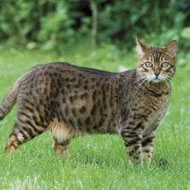Figures show sharp rise in reported cat thefts

The Bengal was the most frequently stolen breed of cat, along with the domestic shorthair.
Cat owners are being urged to keep their pet’s microchip details up-to-date as new figures show a sharp rise in the number of felines stolen across the UK.
Figures published by Direct Line Pet Insurance show that, in the last two years, the number of cats reported as stolen to UK police forces soared by 40 per cent.
Unlike when dogs are stolen, many police forces do not record the breed of cat missing. But of the breeds recorded, the Bengal was stolen most often, along with the domestic shorthair.
The Metropolitan Police reported the highest number of thefts, followed by Kent Police and West Yorkshire Police.
“It is very difficult for owners to know exactly where their cat is all the time due to the large distances they wander,” explained Prit Powar, head of pet insurance at Direct Line.
“If an owner believes their cat is missing, they should first check the immediate vicinity such as in neighbouring gardens or garages as well as asking local people if they have seen it. If their cat is still missing, owners should contact their local animal warden.”
She adds that cat and dog theft is becoming an increasingly popular crime because it is difficult to track the animals down.
“We urge cat owners to make it as difficult for would-be thieves as possible. Keep your details up to date on the microchip database and let thieves know that the cat is neutered. By putting this extra information on the tag connected to their collar, and spreading the word of your cat's disappearance as quickly as possible, helps the pet become ‘too hot to handle’.”
Police forces recovered less than a fifth (18 per cent) of cats reported stolen in 2016, representing a lower recovery rate than dogs (21 per cent).
Analysis by Direct Line Pet Insurance shows that 261 cats were reported as stolen to police forces in 2016 - an increase of 40 per cent on 2014.
Further research by the insurer found the number of cats stolen may actually be far greater than the number reported to police forces. The study found that some 360,000 adults believe they had a cat stolen from their care in the past 12 months.
More than half of these owners (55 per cent) had their cat returned to them after it was taken or as a result of somebody else finding it because of its microchip.



 The RCVS has announced a new version of its 1CPD mobile app, with enhanced features for veterinary surgeons and veterinary nurses to record their continuing professional development.
The RCVS has announced a new version of its 1CPD mobile app, with enhanced features for veterinary surgeons and veterinary nurses to record their continuing professional development.